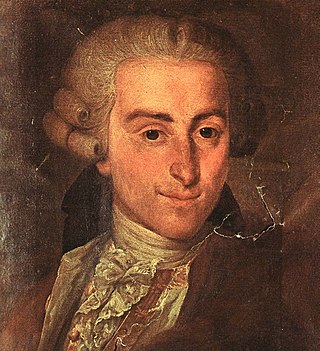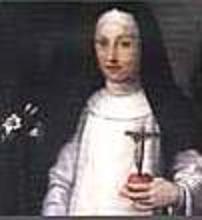Related Research Articles

Giovanni Battista Sammartini was an Italian composer, violinist, organist, choirmaster and teacher. He counted Gluck among his students, and was highly regarded by younger composers including Johann Christian Bach. It has also been noted that many stylizations in Joseph Haydn's compositions are similar to those of Sammartini, although Haydn denied any such influence. Sammartini is especially associated with the formation of the concert symphony through both the shift from a brief opera-overture style and the introduction of a new seriousness and use of thematic development that prefigure Haydn and Mozart. Some of his works are described as galant, a style associated with Enlightenment ideals, while "the prevailing impression left by Sammartini's work... [is that] he contributed greatly to the development of a Classical style that achieved its moment of greatest clarity precisely when his long, active life was approaching its end".
Caterina Assandra was an Italian composer and Benedictine nun. In her surviving motet book, Motetti a due a tre voci op.2, Assandra alludes to her birthplace being in the Province of Pavia. She became famous as an organist and published various works during her lifetime. Her work Motetti a due was dedicated to G.B. Biglia, the Bishop of Pavia, and was first recognized by publisher Lomazzo. Although Assandra had accumulated a substantial reputation for her works as a composer, even reaching outside the borders of Italy, she was at times confused with an 18th-century composer with the same name. And although the date of her birth is approximate, the date of her death is still unknown.
Vittoria Aleottis, believed to be the same as Raffaella Aleotta was an Italian Augustinian nun, a composer and organist.
Laura Peverara or Peperara was an Italian virtuoso singer who was also a harpist and dancer; born and raised in Mantua. Her father, Vincenzo, was a merchant, an intellectual who tutored princes, leading to Laura being brought up in courtly society. In the 1570s she was singing in Verona.
The year 1619 in music involved some significant events.
Vittorio Baldini was an Italian printer and engraver. He started publishing in Venice, where he was born, and later moved to Ferrara, joining the court of Duke Alfonso II d'Este in mid-to-late 1582, where he was the official ducal music printer. He may have met the duke through Giulio Cesare Brancaccio, whose translation and commentary on Julius Caesar's Commentarii de Bello Gallico Baldini printed in early 1582.
Sulpitia Lodovica Cesis was born on 15 May 1577 in Modena, Italy. She was an Italian composer as well as a well-regarded lutenist. Her father was Count Annibale Cesis and he gave 300 pieces of gold for her dowry when she entered the Augustinian convent in Modena in 1593. She was a nun at the convent of Saint Geminiano in Modena, although some sources report it as Saint Agostino. Her only known work is a volume of Motetti Spirituali, which she wrote in 1619.
The year 1609 in music involved some significant events.

The collections of the Pinacoteca Comunale di Cesena, in Cesena, Italy, contain works by:
The year 1604 in music involved some significant events.
The Magnificat Baroque Ensemble, or Magnificat, is an early music ensemble of voices and instruments specializing in the Baroque music of the 17th century under the artistic direction of Baroque cellist Warren Stewart. Stewart founded the ensemble in San Francisco in 1989 with Baroque harpsichordist Susan Harvey. Harvey resigned in 2000, and the group has remained under the sole musical direction of Stewart since then. The group derives its name from the first word of the Latin translation of the Canticle of Mary in the Gospel of Luke, Magnificat anima mea, "My soul magnifies the Lord", which is sung during the Roman Catholic evening prayer or vespers service.
Pietro Chiarini was an Italian composer.

San Benedetto is a late-Baroque architecture, Roman Catholic church and former Benedictine monastery in the city Catania, Sicily, southern Italy. The church facade faces Via Crociferi, parallels across via San Benedetto the former-Jesuit church of San Francesco Borgia, and both are about a block south along Crociferi from the church and convent of San Giuliano. Entrance to church and monastery appear to be through Piazza Asmundo #9 near the apse of the church.

Claudia Sessa was an Italian composer and singer/instrumentalist. She was born into the (de) Sessa family, a patrician clan of the Milanese aristocracy. A nun at the convent of S. Maria Annunciata, she composed two sacred works published in 1613. The dates of her birth and death are uncertain. Gerolamo Borsieri wrote a long and glowing description of her, including that she sang and accompanied herself so well "that there was not a singer who could equal her" and that nobility in Parma and Mantua liked her singing more than "Claudio Monteverdi [or] any other musician in the recitative style..."
Auser Musici is a period instrument ensemble centered in Pisa that specializes in early music repertory from the Tuscan region of Italy.

Sisto Reina was an Italian composer, minorite monk, and organist. His musical publications were made while he was maestro di cappella in the church of S. Francesco in Piacenza.
Maria Xaveria Perucona or Parruccona was a nun and composer in 17th-century Italy.
Arcangelo Guglielmelli was an Italian architect and painter, active in his native Naples, Italy, in a late-Baroque style. He was involved in the building and reconstruction of churches, many of which had been damaged by the earthquakes of 1688 and 1694.
Il Trionfo Di Dori is a collection of 29 Italian madrigals published by Angelo Gardano in Venice in 1592. An edition and commentary was published by Edward Harrison Powley in 1974. In England the collection was imitated in The Triumphs of Oriana. In German the collection was edited as Musicalische Streitkrantzelein.
References
- ↑ Goldberg: early music magazine: Issues 22-25 2003 "Candace Smith y su conjunto Cappella Artemisia han contribuido mucho a promocionar esa música,.."
- ↑ Tactus, ensemble listing